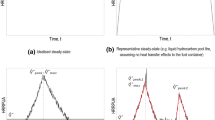Abstract
In this report, a large eddy simulation (LES) model is used to investigate the conventional types of ventilation system design in the context of a public transport interchange. Various airflow patterns based on two of the most popular ventilation designs (mixing and displacement) are simulated to determine their effect on the fire. The simulation program chosen is the fire dynamics simulator (FDS) published by National Institute of Standards and Technology (NIST). It is found that increased airflow causes the fire temperature to increase by as much as 500 K. Extraction of smoke mixture by fans (exhaust only system) significantly decreases the spread of smoke and fire. Ventilation inlets located at the ground level help to increase the smoke and fire intensity in the occupied zone. Displacement ventilation increases fire intensity and current.












Similar content being viewed by others
References
Kirkland C (2002) The fire in the channel tunnel. Underground Space Tunnel Technol 17:129–132
Vuilleumier F, Weatherill A, Crausaz B (2002) Safety aspects of railway and road tunnel: example of the Lötschberg railway tunnel and Mont-Blanc road tunnel. Tunnel Underground Space Technol 17(2):153–158
Fire breaks out in underground car park in Paris, Airline Industry Information-(C)1997–2004 M2 Communications Ltd Gale Group, Farmington Hills, Michigan
British Broadcasting Corporation site, http://www.news.bbc.co.uk/2/hi/uk_news/england/Merseyside/5369894.stm
Breum O, Skotte J (1992) Displacement ventilation in industry—a design principle for improved air quality. Build Environ 27(4):447–453
Breum NO (1992) Ventilation efficiency in an occupied office with displacement ventilation—a laboratory study. Environ Intl 18(4):353–361
Underground cavern development, PNAP 177 Buildings Authority, Hong Kong government of the Special Administrative Region
Chow WK (1998) On safety systems for underground car parks. Tunnel Underground Space Technol 13(3):281–287
Zhang XG, Guo YC, Chan CK, Lin WY (2007) Numerical simulations on fire spread and smoke movement in an underground car park. Build Environ 42(10):3466–3475
Jain S, Kumar S, Kumar S, Sharma TP (2007) Numerical simulation of fire in a tunnel: comparative study of CFAST and CFX predictions. Tunnel Underground Space Technol (In Press), corrected proof, Available online 13 June 2007
Luo M, He Y, Beck V (1997) Application of field model and two-zone model to flashover fires in a full-scale multi-room single level building. Fire Safety J 29(1):1–25
Hu LH, Fong NK, Yang LZ, Chow WK, Li YZ, Huo R (2007) Modeling fire-induced smoke spread and carbon monoxide transportation in a long channel: fire dynamics simulator comparisons with measured data. J Hazard Mater 140(1–2):293–298
Lee SR, Ryou HS (2006) A numerical study on smoke movement in longitudinal ventilation tunnel fires for different aspect ratio. Build Environ 41(6):719–725
Chow WK, Zou GW (2005) Correlation equations on fire-induced air flow rates through doorway derived by large eddy simulation. Build Environ 40(7):897–906
Fire Dynamics Simulator version 4, Technical Reference guide, 2001, National Institute of Standards and Technology special publication 1018, Overview of Storage Development DOE Hydrogen Program. Livermore, CA. Sandia National Laboratories. 2000
Morgan HP, Gardner JP (1990) Design Principles for smoke ventilation on enclosed shopping centers. Building Research establishment Report, Fire research station, Borehamwood, UK
Acknowledgement
The work was supported by Strategic Research Grant No. 7001867 of the City University of Hong Kong.
Author information
Authors and Affiliations
Corresponding author
Rights and permissions
About this article
Cite this article
Lin, Z., Chow, T.T., Tsang, C.F. et al. Effect of Ventilation System on Smoke and Fire Spread in a Public Transport Interchange. Fire Technol 44, 463–479 (2008). https://doi.org/10.1007/s10694-007-0037-1
Received:
Accepted:
Published:
Issue Date:
DOI: https://doi.org/10.1007/s10694-007-0037-1




